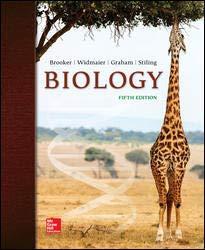
Concept explainers
Introduction: The biological membrane helps to separate the contents of the cell from the outside environment. Besides protecting the cell and maintaining its shape, the membranes play several vital roles. They help in cell signal and transport of molecules in and out of the cell.
Answer to Problem 1TY
Correct answer: The chemical composition of biological membranes can be best described by the statement, “Biological membranes are bilayers of phospholipids with associated proteins and carbohydrates”. Hence, the correct answer is option c.
Explanation of Solution
Reason for correct answer:
The membrane is made up of a bilayer of phospholipids. It can be confirmed by taking a look at the nature of the membrane which is both fluid and rigid. It consists of polar heads of phospholipids on the outside and is made up of hydrophobic tails from the inside. Thus, the membrane is polar from the exterior of the layer and hydrophobic from the interior.
The presence of proteins can be easily detected by the presence of various peripheral proteins and protruded fragments of integral proteins. Also, the receptors and associated structures confirm the presence of glycolipids and glycoprotein (made up of carbohydrate) in the membrane.
Option c. is given as “Biological membranes are bilayers of phospholipids with associated proteins and carbohydrates”.
Biological membranes are composed of bilayer of phospholipids along with the proteins and carbohydrate molecules. Hence, the correct answer is option c.
Reasons for the incorrect answer:
Option a. is given as, “Biological membranes are bilayers of proteins with associated lipids and carbohydrates”.
Biological membranes are composed of bilayer of phospholipids not proteins. The membrane is associated with proteins and carbohydrate molecules. Hence, option a. is incorrect.
Option b. is given as, “Biological membranes are composed of two layers-one layer of phospholipids and one layer of proteins”.
Biological membranes are not made up of a layer of proteins and a layer of phospholipids. Hence, option b. is incorrect.
Option d. is given as, “Biological membranes are composed of equal numbers of phospholipids, proteins, and carbohydrates”.
The protein and carbohydrate content in the biological membrane is very small compared to the phospholipids. Hence, option d. is incorrect.
Option e. is given as, “Biological membranes are composed of lipids with proteins attached to the outer surface”.
The polar ends of the phospholipids make the polar head on either side of the membrane. This is possible due to the presence of polar side chains of phosphate. The lipids lack polar ends and hence it cannot form a membrane. Hence, option e. is incorrect.
Hence, the options a., b., d., and e. are incorrect.
The biological membranes is made up with phospholipids bilayers along with proteins and carbohydrates.
Want to see more full solutions like this?
Chapter 5 Solutions
BIOLOGY-TEXT
- Outline the negative feedback loop that allows us to maintain a healthy water concentration in our blood. You may use diagram if you wisharrow_forwardGive examples of fat soluble and non-fat soluble hormonesarrow_forwardJust click view full document and register so you can see the whole document. how do i access this. following from the previous question; https://www.bartleby.com/questions-and-answers/hi-hi-with-this-unit-assessment-psy4406-tp4-report-assessment-material-case-stydu-ms-alecia-moore.-o/5e09906a-5101-4297-a8f7-49449b0bb5a7. on Google this image comes up and i have signed/ payed for the service and unable to access the full document. are you able to copy and past to this response. please see the screenshot from google page. unfortunality its not allowing me attch the image can you please show me the mathmetic calculation/ workout for the reult sectionarrow_forward
- Skryf n kortkuns van die Egyptians pyramids vertel ñ story. Maximum 500 woordearrow_forward1.)What cross will result in half homozygous dominant offspring and half heterozygous offspring? 2.) What cross will result in all heterozygous offspring?arrow_forward1.Steroids like testosterone and estrogen are nonpolar and large (~18 carbons). Steroids diffuse through membranes without transporters. Compare and contrast the remaining substances and circle the three substances that can diffuse through a membrane the fastest, without a transporter. Put a square around the other substance that can also diffuse through a membrane (1000x slower but also without a transporter). Molecule Steroid H+ CO₂ Glucose (C6H12O6) H₂O Na+ N₂ Size (Small/Big) Big Nonpolar/Polar/ Nonpolar lonizedarrow_forward
- what are the answer from the bookarrow_forwardwhat is lung cancer why plants removes liquid water intead water vapoursarrow_forward*Example 2: Tracing the path of an autosomal dominant trait Trait: Neurofibromatosis Forms of the trait: The dominant form is neurofibromatosis, caused by the production of an abnormal form of the protein neurofibromin. Affected individuals show spots of abnormal skin pigmentation and non-cancerous tumors that can interfere with the nervous system and cause blindness. Some tumors can convert to a cancerous form. i The recessive form is a normal protein - in other words, no neurofibromatosis.moovi A typical pedigree for a family that carries neurofibromatosis is shown below. Note that carriers are not indicated with half-colored shapes in this chart. Use the letter "N" to indicate the dominant neurofibromatosis allele, and the letter "n" for the normal allele. Nn nn nn 2 nn Nn A 3 N-arrow_forward

 Concepts of BiologyBiologyISBN:9781938168116Author:Samantha Fowler, Rebecca Roush, James WisePublisher:OpenStax College
Concepts of BiologyBiologyISBN:9781938168116Author:Samantha Fowler, Rebecca Roush, James WisePublisher:OpenStax College Human Biology (MindTap Course List)BiologyISBN:9781305112100Author:Cecie Starr, Beverly McMillanPublisher:Cengage Learning
Human Biology (MindTap Course List)BiologyISBN:9781305112100Author:Cecie Starr, Beverly McMillanPublisher:Cengage Learning Biology 2eBiologyISBN:9781947172517Author:Matthew Douglas, Jung Choi, Mary Ann ClarkPublisher:OpenStax
Biology 2eBiologyISBN:9781947172517Author:Matthew Douglas, Jung Choi, Mary Ann ClarkPublisher:OpenStax Biology Today and Tomorrow without Physiology (Mi...BiologyISBN:9781305117396Author:Cecie Starr, Christine Evers, Lisa StarrPublisher:Cengage Learning
Biology Today and Tomorrow without Physiology (Mi...BiologyISBN:9781305117396Author:Cecie Starr, Christine Evers, Lisa StarrPublisher:Cengage Learning Human Physiology: From Cells to Systems (MindTap ...BiologyISBN:9781285866932Author:Lauralee SherwoodPublisher:Cengage Learning
Human Physiology: From Cells to Systems (MindTap ...BiologyISBN:9781285866932Author:Lauralee SherwoodPublisher:Cengage Learning





